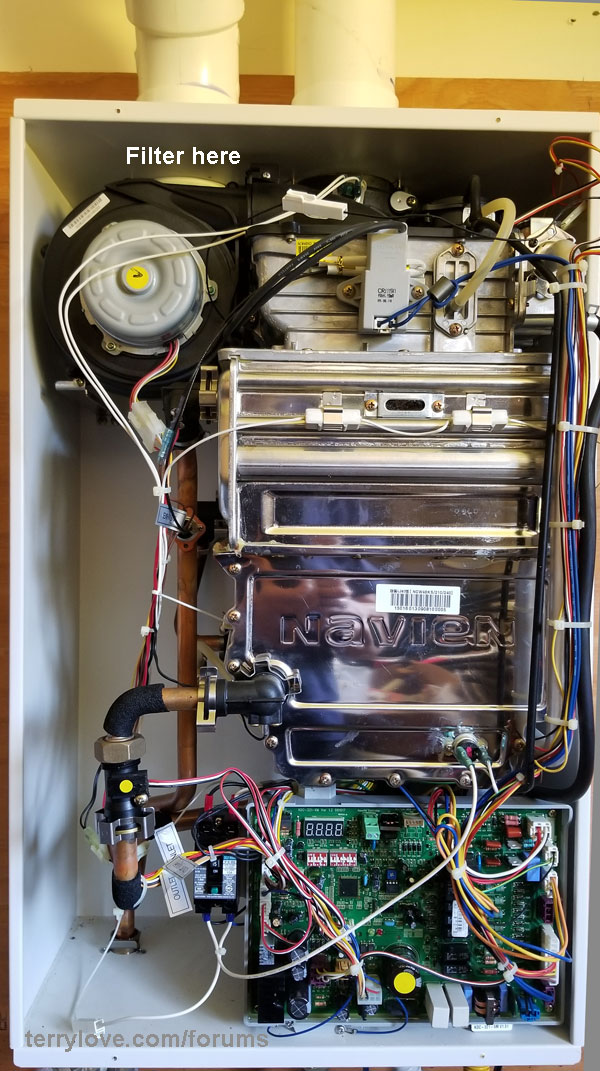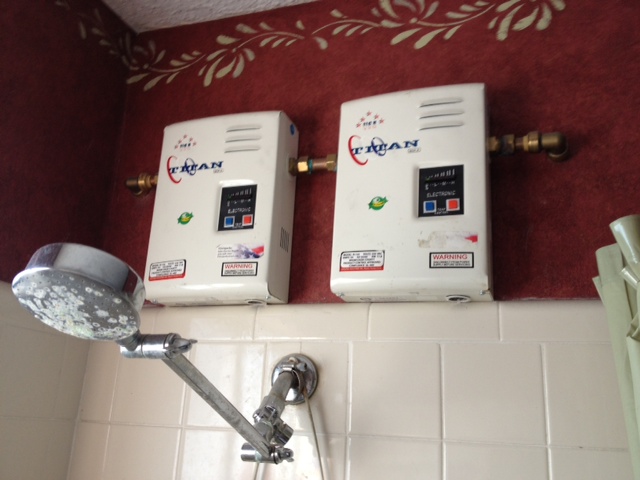An electric tankless water heater may get hot then cold due to fluctuations in water flow or temperature settings. This issue can also stem from a faulty heating element or mineral buildup.
Electric tankless water heaters offer an efficient way to supply hot water on demand. Unlike traditional tank heaters, they heat water directly as it flows through the unit. This means you enjoy a continuous supply of hot water without waiting for a tank to refill.
However, users may encounter problems, such as inconsistent water temperature. Understanding the reasons behind these fluctuations can help you troubleshoot effectively. Addressing issues early can improve efficiency and prolong the lifespan of your unit. Explore common causes and solutions to ensure you maintain a steady flow of hot water in your home.

Credit: www.reddit.com
Page Contents
- 1 Introduction To Electric Tankless Water Heaters
- 2 Symptoms Of Temperature Fluctuations
- 3 Potential Causes Of Inconsistent Heating
- 4 Quick Diagnostic Steps
- 5 Simple Fixes Anyone Can Do
- 6 When To Reset Your System
- 7 Maintenance Tips To Prevent Fluctuations
- 8 Advanced Troubleshooting Techniques
- 9 Understanding The Role Of Water Pressure
- 10 When To Consider A Replacement
- 11 Conclusion: Achieving Consistent Hot Water
- 12 Frequently Asked Questions
- 13 Conclusion
Introduction To Electric Tankless Water Heaters
Electric tankless water heaters are gaining popularity. They provide hot water on demand. This means no waiting for a tank to fill. Many people prefer this energy-efficient option.
Some common myths exist about tankless water heaters. One myth is that they cannot provide enough hot water. In reality, they can supply hot water for multiple outlets. Another myth claims they are too expensive to install. While the upfront cost is higher, they save money over time.
People often think tankless heaters are hard to maintain. Regular maintenance is simple and keeps them running well. Understanding these facts helps consumers make better choices.
Symptoms Of Temperature Fluctuations
Temperature fluctuations in your electric tankless water heater can be frustrating. Identifying hot and cold spots is key to understanding the problem. Check various taps in your home. Notice if water temperature changes while running. This could indicate issues with your heater.
Common symptoms include sudden bursts of cold water. This might happen during a shower or while washing dishes. Another sign is water that does not reach the desired temperature. These symptoms suggest the need for further inspection.
Seek professional help if you notice frequent fluctuations. An expert can diagnose issues quickly. They will check for problems like sediment build-up or faulty heating elements. Regular maintenance can also prevent these issues.
Potential Causes Of Inconsistent Heating
Electrical supply issues can cause inconsistent water heating. A weak electrical connection may lead to fluctuating temperatures. Check for any loose wires or faulty circuits. Poor voltage can also affect heater performance.
Water flow complications might disrupt heating. Low water pressure can cause the heater to turn off. Also, sediment build-up in pipes can restrict water flow. Regular maintenance helps avoid these problems.
Quick Diagnostic Steps
Check the power source first. Make sure the unit is plugged in. Inspect circuit breakers to ensure they are not tripped. If necessary, reset them to restore power.
Next, evaluate the flow rate. A low flow rate can cause inconsistent heating. Measure the flow using a bucket. Ensure it meets the manufacturer’s requirements for optimal performance.
If the flow rate is too low, consider cleaning or replacing the faucet aerator. This can improve water flow and enhance heating efficiency.
Always refer to the user manual for specific troubleshooting steps. Regular maintenance helps keep the unit running smoothly.
Simple Fixes Anyone Can Do
Cleaning the inlet screen can help fix water temperature issues. Dirt and debris can block the flow. Turn off the power first. Remove the inlet screen carefully. Rinse it under running water. Ensure it is clean before reinstalling.
Adjusting the temperature dial is another simple fix. Find the dial on your heater. Turn it to a higher setting if water feels cold. Wait a few minutes to check the water temperature. Make small adjustments until it feels just right.
When To Reset Your System
Resetting your electric tankless water heater can fix many issues. Follow the reset process carefully. First, turn off the power. Wait for about 10 seconds. Then, turn the power back on. Check the water temperature. Make sure it is at a safe level.
Always follow safety precautions during this process. Wear protective gloves to avoid burns. Ensure the area is dry to prevent electrical shocks. Do not use metal tools near the heater. Keep children and pets away from the area.
By following these steps, you can maintain your heater safely and efficiently.
Maintenance Tips To Prevent Fluctuations
Regular cleaning is key for your electric tankless water heater. Dust and mineral buildup can cause temperature issues. Flush the system at least once a year. This will remove any scale and improve efficiency.
Annual professional inspections help catch problems early. A technician can check for leaks or other issues. They will ensure your unit runs smoothly and safely. Proper maintenance can extend the lifespan of your heater.
| Maintenance Task | Frequency |
|---|---|
| Flush System | Once a Year |
| Professional Inspection | Once a Year |
| Check Filters | Every 3 Months |

Credit: terrylove.com
Advanced Troubleshooting Techniques
Calibrating the thermostat is crucial for consistent water temperature. Adjust the setting to match your needs. Check the manual for specific instructions. A proper calibration helps avoid hot and cold water issues.
Checking for internal blockages is essential in maintaining performance. Start by inspecting the water inlet and outlet. Look for debris or mineral buildup. Clean any blockages carefully to restore proper flow.
Regular maintenance prevents problems. Schedule routine checks to ensure everything runs smoothly. This will help extend the life of your electric tankless water heater.
Understanding The Role Of Water Pressure
Water pressure plays a big role in how hot water gets. High pressure can help maintain a steady temperature. Low pressure may cause the water to feel cold at times. This is due to the heater’s inability to keep up.
When the water pressure is inconsistent, it can lead to temperature fluctuations. Adjusting the pressure can help keep water at a constant heat. Check for any leaks in pipes, as they can lower pressure. Using a pressure regulator can also be effective. It helps maintain an even flow of water.
| Solution | Description |
|---|---|
| Check for Leaks | Fixing leaks can improve water pressure. |
| Install Pressure Regulator | This device helps maintain consistent pressure levels. |
| Adjust Home Fixtures | Ensure all faucets and fixtures are in good condition. |

Credit: www.greenbuildingadvisor.com
When To Consider A Replacement
The lifespan of tankless water heaters typically ranges from 15 to 20 years. Regular maintenance can extend this lifespan. Signs that indicate it’s time for a new unit include:
- Inconsistent water temperature: Water gets hot, then cold.
- Increased energy bills: Noticeable spikes in energy costs.
- Frequent repairs: Constant need for fixes and services.
- Rusty water: Discolored water may signal issues.
- Strange noises: Unusual sounds from the unit can indicate problems.
Replacing an old unit can improve efficiency. It also ensures a consistent hot water supply. Choose a model that fits your needs for the best performance.
Conclusion: Achieving Consistent Hot Water
Electric tankless water heaters provide instant hot water. They heat water on demand, which saves energy. However, some users experience temperature fluctuations. This can be frustrating, especially during long showers.
Key takeaways include:
- Proper sizing is crucial for consistent hot water.
- Regular maintenance helps ensure reliable performance.
- Consider peak demand times to avoid cold water surprises.
Reliable water heaters offer comfort and convenience. Choose a quality model to minimize issues. Understanding how they work can help you enjoy consistent hot water.
Frequently Asked Questions
Why Is My Tankless Water Heater Going Hot And Cold?
A tankless water heater may go hot and cold due to insufficient flow rate or mineral buildup. Fluctuations can also occur from multiple fixtures using hot water simultaneously. Check for any leaks or malfunctioning parts that could impact performance. Regular maintenance helps prevent these issues.
Why Is My Tankless Water Heater Not Staying Warm?
Your tankless water heater may not stay warm due to a malfunctioning thermostat, sediment buildup, or insufficient gas supply. Check for blockages in the venting system and ensure the unit is sized correctly for your household needs. Regular maintenance can prevent these issues.
Why Is My Electric Tankless Water Heater Not Heating Consistently?
Inconsistent heating from your electric tankless water heater may stem from insufficient power supply, sediment buildup, or incorrect temperature settings. Check the circuit breaker, clean the unit, and adjust the thermostat. Regular maintenance ensures optimal performance and consistent hot water delivery.
Why Does My Tankless Water Heater Fluctuate In Temperature?
Fluctuations in temperature from a tankless water heater can occur due to inconsistent water flow, sediment buildup, or improper sizing. Cold and hot water mixing can also cause variations. Regular maintenance and ensuring proper installation can help stabilize the temperature.
Conclusion
Electric tankless water heaters can offer consistent hot water, but issues may arise. Fluctuating temperatures often stem from incorrect sizing or installation. Regular maintenance can also help prevent these problems. By addressing these factors, you can enjoy reliable hot water on demand.
Make informed choices for a comfortable home experience.
